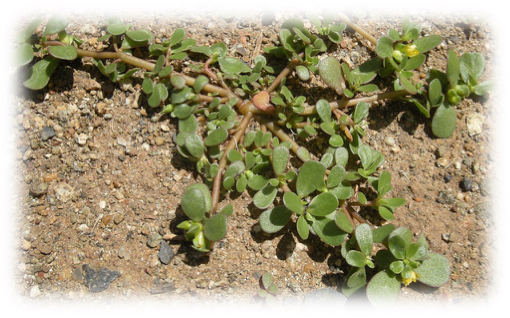Region
Thompson Shuswap
HOW TO IDENTIFY?
- It’s a succulent plant with thick,
rounded leaves and reddish stems
that can store water.- It grows horizontally on the ground, forming a dense, circular mat.
- Flowers are small and only open on
SUNNY MORNINGS.- Looks similar to spurge, which is poisonous.
IS THIS ANNUAL A PROBLEM?
- NO. It is very nutritious, with high levels of omega-3 fatty acids, anti-oxidants, vitamins and minerals.
- Can be added to salads, sauteed like spinach, or used in soups and stews (it will thicken stews).
- Has a slightly lemony flavour and is less bitter than many other edible weeds.
- If fed to chickens it will increase the omega-3 fatty acids in their eggs.
- YES. It spreads aggressively – one plant can produce up to 240,000 seeds!
HOW DOES IT GROW?
- Seeds need light and temperatures over 24C to germinate.
- Grows in almost any soil and is drought tolerant.
- Likes DISTURBED soil and full sun (doesn’t grow in shade).
- Seeds can remain viable in the soil for up to 40 YEARS!
- Can grow new plants from pieces of stem.
HOW TO CONTROL?
- Hoeing and tiling may not help because pieces of purslane will grow into new plants.
- Hand-pull it when young, making sure to get all the roots.
- MULCH INSTEAD of tilling, to prevent new seeds from germinating.
Sources:
Kampman, M. Master Gardeners: Many consider purslane a weed, but it’s a powerhouse of nutrition.
Marin Independent Journal. July 19, 2018.
Royer, F. and Dickinson, R. Weeds of Canada and the Northern United States. 1999.
Image: Ethel Aardvark, CC BY 3.0 <https://creativecommons.org/licenses/by/3.0>, via Wikimedia Commons
PDF
| Attachment | Size |
|---|---|
| PURSLANE_0.pdf | 100.76 KB |
